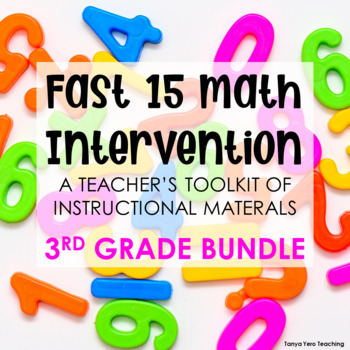3rd Grade Math Intervention Teacher Toolkit Hands-on Lessons | YEARLONG BUNDLE
- Zip
What educators are saying
Products in this Bundle (5)
Also included in
- This Fast 15 Math Intervention resource is a teacher toolkit of everything needed to provide 2nd grade and 3rd grade math small group intervention instruction. Your kit includes instructional lesson plans, instructional talking prompts, and hands-on mats/templates. The materials are scaffolded by abPrice $48.00Original Price $61.00Save $13.00
- This Fast 15 Math Intervention resource is a teacher toolkit of everything needed to provide 2nd grade, 3rd grade, 4th grade and 5th grade math small group intervention instruction. Your kit includes instructional lesson plans, instructional talking prompts, and hands-on mats/templates. The materialPrice $94.00Original Price $123.50Save $29.50
Description
This Fast 15 Math Intervention resource is a teacher toolkit of everything needed to provide small group intervention instruction. Your kit includes instructional lesson plans, instructional talking prompts, and hands-on mats/templates. The materials are scaffolded by ability and rigor and cover both procedural and conceptual understanding.
UNDERSTANDING THE MATERIALS:
INSTRUCTIONAL PLANS – these are your ready to print lesson plans. They house your objectives, essential questions, and common misconceptions. Use these for guidance during your instruction. You can also turn these lesson plans into admin.
INSTRUCTIONAL PROMPTS – this is your script of questions to ask students during instruction. The questions are scaffolded by ability and rigor. You are covering both procedural and conceptual understanding with these prompts.
HANDS ON MATS/ TEMPLATES – these are ready to print activities designed to deepen understanding and provide a hands on component to your lesson. Some templates have prompts built in, while others are designed for you to enter numbers based on the ability of your student/ group.
STANDARDS COVERED:
Number and Operation in Base Ten-
- 3.NB.1 - Place value concepts
- 3.NBT.2 - Adding & subtracting whole numbers
- 3.NBT.3 - Multiplying numbers
Operations & Algebraic Thinking-
- 3.OA.1 - Interpreting products of whole numbers
- 3.OA.2 – Interpreting quotients of whole numbers
- 3.OA.3 – Use multiplication and division to solve word problems
- 3.OA.4 – Determining unknown numbers in a multiplication or division equation
- 3.OA.5 – Apply properties of operations to multiply and divide
- 3.OA.6 – Understand division as an unknown-factor problem
- 3.OA.7 – Fluently multiply and divide within 100
- 3.OA.8 – Solve two-step word problems using the four operations
- 3.OA.9 – Understanding patterns on a multiplication chart
Number and Operation - Fractions-
- 3.NF.1 – Understanding fractions
- 3.NF.2 – Understanding fractions on number lines
- 3.NF.3 – Equivalent fractions and comparting fractions
Measurement and Data-
- 3.MD.1 – Understanding time
- 3.MD.2 – measuring and understanding liquid volume and mass
- 3.MD.3 – Picture graphs
- 3.MD.4 – Measuring length and using line plots
- 3.MD.5 – Understanding area
- 3.MD.6 - Measuring area
- 3.MD.7 - Relate area to the operations of multiplication and addition.
- 3.MD.8 – Word problems with area and perimeter
Geometry-
- 3.G.1 – Understanding and examining shapes
- 3.G.2 - Partition shapes into parts with equal areas.
WHY YOU NEED THIS RESOURCE:
- Differentiate your math block with ease
- Ready to go Tier II and Tier III materials
- Designed to be completed in 15 minutes or less
BENEFITS OF THIS RESOURCE:
- Saves you preparation time
- Addresses the needs of the bottom quartile in your classroom
- Designed with research based strategies in mind
- Includes hands-on activities to build conceptual understanding
This resource is designed as a teacher toolkit for small group instruction/ re-teaching efforts. Our Math Intervention Student Packs include ready to print student pages and assessments. These practice printables along with standards based quick checks and domain pre-tests cover procedural and conceptual understanding. With these Math Intervention Packs you can identify the exact level of understanding of your students.







